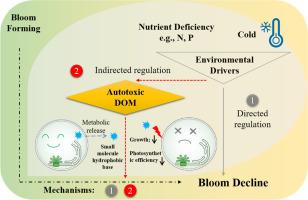当前位置:
X-MOL 学术
›
Water Res.
›
论文详情
Our official English website, www.x-mol.net, welcomes your
feedback! (Note: you will need to create a separate account there.)
The autotoxicity of dissolved organic matter from Microcystis may be a contributor to the decline of its bloom
Water Research ( IF 11.4 ) Pub Date : 2024-10-28 , DOI: 10.1016/j.watres.2024.122710 Jun Sha, Lirong Song, Chao Liu, Fang Bai, Haiyang Zhang, Zichao Gong, Tianli Li, Jin Liu, Guangbin Gao, Yunlu Jia
Water Research ( IF 11.4 ) Pub Date : 2024-10-28 , DOI: 10.1016/j.watres.2024.122710 Jun Sha, Lirong Song, Chao Liu, Fang Bai, Haiyang Zhang, Zichao Gong, Tianli Li, Jin Liu, Guangbin Gao, Yunlu Jia

|
Microcystis blooms frequently occur in freshwaters worldwide, causing detrimental impacts on the ecosystems and human health. Studying the mechanisms behind the decline of Microcystis blooms can aid in mitigating their harmful effects. However, there is currently a dearth of research in this area. In this study, we examined the dissolved organic matter (DOM) collected during the growth of axenic Microcystis. Axenic Microcystis produces toxic DOM during its growth, which accumulate in the medium. Further, the DOM obtained from decline phase of Microcystis blooms exhibited a strong inhibitory effect on the growth of fresh Microcystis cultures. It is postulated that DOM may contribute to decline of Microcystis blooms. Meanwhile, potential autotoxic components in Microcystis DOM were analyzed by integrating column chromatography fractionation, identification and Microcystis growth inhibition assay. The results showed that the autotoxic components consisted mainly of small molecule hydrophobic base. Moreover, we evaluated the influence of key environmental factors such as nutrient and temperature on the autotoxic DOM in Microcystis cultures. Nutrient deficiency and low temperature may promote the accumulation of autotoxic substances. The study provided a new perspective on the decay process of cyanobacterial bloom, and offered new ideas for the development of natural algicidal agents.
中文翻译:

微囊藻溶解有机物的自身毒性可能是其水华减少的一个原因
微囊藻大量繁殖经常发生在世界各地的淡水中,对生态系统和人类健康造成不利影响。研究微囊藻大量繁殖减少背后的机制有助于减轻其有害影响。然而,目前缺乏该领域的研究。在这项研究中,我们检查了轴生微囊藻生长过程中收集的溶解有机物 (DOM)。Axenic Microcystis 在生长过程中会产生有毒的 DOM,这些 DOM 在培养基中积累。此外,从微囊藻华的衰落期获得的 DOM 对新鲜微囊藻培养物的生长表现出很强的抑制作用。据推测,DOM 可能有助于微囊藻大量繁殖的减少。同时,通过整合柱层析分离、鉴定和微囊藻生长抑制测定,分析微囊藻 DOM 中潜在的自身毒性成分。结果表明,自毒成分主要由小分子疏水碱组成。此外,我们评估了营养和温度等关键环境因素对微囊藻培养物中自身毒性 DOM 的影响。营养缺乏和低温可能促进自身毒性物质的积累。该研究为蓝藻水华的腐烂过程提供了新的视角,并为天然灭藻剂的开发提供了新思路。
更新日期:2024-11-01
中文翻译:

微囊藻溶解有机物的自身毒性可能是其水华减少的一个原因
微囊藻大量繁殖经常发生在世界各地的淡水中,对生态系统和人类健康造成不利影响。研究微囊藻大量繁殖减少背后的机制有助于减轻其有害影响。然而,目前缺乏该领域的研究。在这项研究中,我们检查了轴生微囊藻生长过程中收集的溶解有机物 (DOM)。Axenic Microcystis 在生长过程中会产生有毒的 DOM,这些 DOM 在培养基中积累。此外,从微囊藻华的衰落期获得的 DOM 对新鲜微囊藻培养物的生长表现出很强的抑制作用。据推测,DOM 可能有助于微囊藻大量繁殖的减少。同时,通过整合柱层析分离、鉴定和微囊藻生长抑制测定,分析微囊藻 DOM 中潜在的自身毒性成分。结果表明,自毒成分主要由小分子疏水碱组成。此外,我们评估了营养和温度等关键环境因素对微囊藻培养物中自身毒性 DOM 的影响。营养缺乏和低温可能促进自身毒性物质的积累。该研究为蓝藻水华的腐烂过程提供了新的视角,并为天然灭藻剂的开发提供了新思路。


















































 京公网安备 11010802027423号
京公网安备 11010802027423号